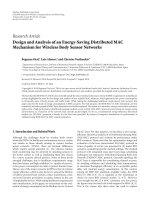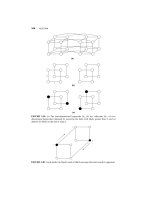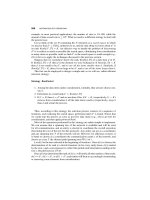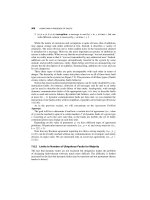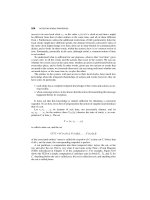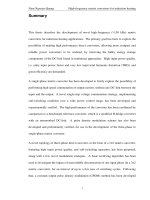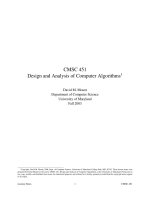Design and analysis of algorithms for solving a class of routing shop scheduling problems
Bạn đang xem bản rút gọn của tài liệu. Xem và tải ngay bản đầy đủ của tài liệu tại đây (942.96 KB, 162 trang )
DESIGN AND ANALYSIS OF ALGORITHMS FOR
SOLVING A CLASS OF ROUTING SHOP
SCHEDULING PROBLEMS
LIU SHUBIN
NATIONAL UNIVERSITY OF SINGAPORE
2008
DESIGN AND ANALYSIS OF ALGORITHMS FOR
SOLVING A CLASS OF ROUTING SHOP
SCHEDULING PROBLEMS
LIU SHUBIN
(M.Eng. NUS)
A THESIS SUBMITTED
FOR THE DEGREE OF DOCTOR OF PHILOSOPHY
DEPARTMENT OF INDUSTRIAL & SYSTEMS ENGINEERING
NATIONAL UNIVERSITY OF SINGAPORE
2008
i
Acknowledgements
First and foremost, I would like to express my sincere gratitude and
appreciation to my two supervisors, Associate Professor Ong Hoon Liong and Dr. Ng
Kien Ming, for their invaluable advice and patient guidance throughout the whole
course of my research. It would be impossible for me to carry out the research work
reported in this dissertation without their guidance. In addition, their meticulous
attitude towards research and their kind personality will always be remembered. I
would also like to take this opportunity to thank all the other faculty members of the
department of Industrial & Systems Engineering, from whom I have learned a lot
through both coursework and seminars.
Special appreciation also goes to my fellow research students in the department
of Industrial & Systems Engineering. Particularly, I am grateful to Han Dongling,
Wang Qiang, Zhou Qi, Li Juxin, Sun Hainan, Fu Yinghui, Bae Minju, Chen Liqin,
Xing Yufeng, Chang Hongling and Lahlou Kitane Driss, who kindly offered help in
one way or another. I would also like to extend my appreciation to those students
whose names are not listed here.
Last but not least, special thanks are due to my parents, my wife Zeng Ling,
and my son Xin Ji. They gave me continuous encouragement and warm support during
the course of my Ph.D. study. This dissertation is dedicated to them.
ii
TABLE OF CONTENTS
Acknowledgements i
Abstract… iv
List of Tables vii
List of Figures… viii
List of Symbols ix
Chapter 1 Introduction 1
1.1 Background 1
1.2 Overview of General Solution Methodology 2
1.3 Motivation and Purpose of this Study 4
1.4 Organization of this Dissertation 5
Chapter 2 Literature Review 6
2.1 Classification of of Machine Scheduling Problems 6
2.2 Algorithms for Classical Machine Scheduling Problem 10
2.2.1 Single Machine Scheduling Problem 11
2.2.2 Flow Shop Scheduling Problem 16
2.2.3 Job Shop Scheduling Problem 18
2.2.4 Open Shop Scheduling Problem 22
2.3 Algorithms for Routing Shop Scheduling Problem 25
2.3.1 Single Machine Scheduling Problem with Transportation 26
2.3.2 Flow Shop Scheduling Problem with Transportation Times 29
2.3.3 Open Shop Scheduling Problem with Transportation Times 29
2.4 Limitation of Previous Research Work 30
Chapter 3 Branch-and-Bound Algorithm for Solving Single Machine
Total Weighted Tardiness Problem with Unequal Release
Dates 31
3.1 Introduction 31
3.2 Dominance Rules 33
3.3 Lower Bound 38
3.4 Branch-and-Bound Procedure 44
3.4.1 Enumeration Method 44
3.4.2 Tree Reduction Criteria 45
3.4.3 Implementation of the Branch-and-Bound Algorithm 46
3.5 Computational Results 48
3.5.1 Computational Comparison of Lower Bounds 49
3.5.2 Efficiency of Tree Reduction 51
3.5.3 Comparison of the Three Lower Bound Strategies 56
3.6 Conclusions 60
Chapter 4 An Overlapped Neighborhood Search Algorithm for
Sequencing Problems 62
4.1 Introduction 62
4.2 Overlapped Neighborhood Search Algorithm 64
4.2.1 Overlapped Neighborhoods 65
4.2.2 ONS Algorithm Framework 65
4.3 Block Improvement Procedures 67
4.3.1 Generalized Crossing (GC) Method 68
4.3.2 Problem Independent Algorithms Developed for TSP 69
iii
4.3.3 Insertion and Interchange Based Local Search Procedures 71
4.4. Implementation Procedure 72
4.5 Computational Experiments 73
4.5.1 Computational Experiments for the SMSP with Unequal Release
Dates… 73
4.5.2 Computational Experiments for the SMSP Sequence with Dependent
Setup Times 84
4.6. Concluding Remarks 92
Chapter 5 Tabu Search Algorithms for the Open Shop and Routing
Open Shop Scheduling Problems 93
5.1 Introduction 93
5.2 Problem and Schedule Formulation 94
5.2.1 Disjunctive Graph Problem Representation 95
5.2.2 Acyclic Graph Schedule Representation 96
5.3 Feasibility Checking Procedure 99
5.4 Tabu Search Strategies 102
5.4.1 Aspiration Criterion 103
5.4.2 Back Jump Tracking 103
5.4.3 Cycle Detection Method 105
5.5 Application of TS to the Open Shop Scheduling Problem 106
5.5.1 Initial Solutions 106
5.5.2 Lower Bound 107
5.5.3 Neighborhoods 107
5.5.4 Tabu Search Algorithm for the OSSP 110
5.6 Application of TS to the Routing Open Shop Scheduling Problem 117
5.6.1 Initial Solutions 118
5.6.2 Lower Bound 118
5.6.3 Neighborhoods 119
5.6.4 Tabu Search Algorithm 120
5.6.5 Computational Results 121
5.7 Conclusions 124
Chapter 6 Conclusions and Future Research Work 125
6.1 Summary and Conclusions 125
6.2 Future Research 128
References 129
iv
Abstract
The role of manufacturing scheduling is to allocate scarce resources to tasks in
order to maximize or minimize one or more objectives. Scheduling is a key decision
making process and plays an important role in modern manufacturing systems. In
modern manufacturing system, the resources may be machines, time, manpower, space,
or all of them. In the last four decades, considerable research work have been
conducted on classical machine scheduling problems, in which it is often assumed that
products can be moved between machines instantaneously, or that machines can travel
from one location to another location instantaneously. This assumption may not be
valid as it ignores product or machine traveling times, or machine setup times that are
inevitable in practice. Therefore, it is necessary to develop machine scheduling
algorithms which consider transportation or setup times, in order to reflect real
manufacturing scheduling environments better.
By considering transportation times or sequence dependent setup times, the
routing shop scheduling problems considered in this research work become an
extension of classical shop scheduling problems. As classical shop scheduling
problems are special types of routing shop scheduling problems where transportation
or setup times are ignored, the algorithms developed for the routing shop scheduling
problems can also be applied to the corresponding classical shop scheduling problem
where the transportation or setup times are ignored.
In this study, a branch-and-bound algorithm for solving single machine total
weighted tardiness problem with unequal release dates was developed. The objective
of the problem is to minimize the total weighted tardiness by sequencing the job
processing order on a single machine. Three global dominance rules as well as a lower
bound computational method were proposed to prune the search tree branches. The
v
efficiency of the dominance rules and the lower bound computational method were
assessed based on comprehensive computational experiments. Our computation results
show that the dominance rules and the lower bound are effective in pruning the search
tree branches.
In this study, we also developed a general-purpose heuristic, named overlapped
neighborhood search (ONS) algorithm, for single machine scheduling problems with
or without transportation or setup times. The basic idea of the ONS algorithm is to
divide a permutation of the schedule into overlapped blocks; subsequently, the
neighborhood of each block is explored independently. The ONS algorithm is also
applicable to a wide variety of sequencing problems, such as various single machine
scheduling problems, the traveling salesman problem, the linear ordering problem, the
quadratic assignment problems, the bandwidth reduction problems and other problems
whose solutions can be represented by permutations. The ONS algorithm has been
applied to single machine scheduling problems with unequal release dates and the
single machine scheduling problem with sequence dependent setup times. The
computational experiments carried out in our research work show that the ONS
algorithm is efficient in finding near optimal solutions for single machine scheduling
problems within reasonable computation times.
The previously mentioned work focuses on single machine scheduling
problems. In this research work, heuristics were also developed for two multi-machine
scheduling problems, open shop scheduling problems and routing open shop
scheduling problems. New neighborhood structures were defined for the two multi-
machine scheduling problems. In addition, an exact and fast operation move feasibility
checking method was developed for the multi-machine scheduling problems to remove
infeasible operation moves quickly. Tabu search algorithms were developed for open
vi
shop and routing open shop scheduling problems based on the new neighborhoods and
the new feasibility checking method. To test the performance of the neighborhood
structures and the feasibility checking method, comprehensive computational
experiments were conducted based on benchmarks and randomly generated problem
instances. The computational results show that the tabu search algorithms embedded
with the new neighborhoods are able to find optimal or near optimal solutions for most
of the problem instances tested, within reasonable computation times.
vii
List of Tables
Table 3.1 Settings for generating problem instances 48
Table 3.2 Comparison of lower bounds 50
Table 3.3 Global dominance relationships 52
Table 3.4 Comparison of efficiency of dominance rules based on Strategy I 54
Table 3.5 Comparison of efficiency of dominance rules based on Strategy II 55
Table 3.6 Comparison of efficiency of dominance rules based on Strategy III 55
Table 3.7 ANOVA for dominance rules and lower bounds 56
Table 3.8 Computational results for n = 10 56
Table 3.9 Computational results for n = 20 57
Table 3.10 Computational results for n = 30 58
Table 3.11 Computational results of Akturk and Ozdemir (2000) for n = 20 59
Table 4.1 Problem generating parameters 74
Table 4.2 Computational results of ONS and LDR 75
Table 4.3 The average improvement in percentage for n = 100 78
Table 4.4 Computational results for iterative ONS 83
Table 4.5 Experimental design of problem instances 88
Table 4.6 Comparison of experimental results for small problem set 90
Table 4.7 Comparison of experimental results for large problem set 91
Table 5.1 Results for the Taillard’s benchmark problems 115
Table 5.2 Settings for generating ROSSP instances 121
Table 5.3 Computational results 122
Table 5.4 ANOVA for TS solution relative deviations 123
Table 5.5 ANOVA for TS computation time 123
viii
List of Figures
Figure 1.1 The relationship of three types of schedules 10
Figure 3.1 Illustration of exchanging jobs 35
Figure 3.2 Job relationships after exchanging jobs 38
Figure 4.1 Black box model for the ONS algorithm 64
Figure 4.2 Illustration of the overlapped blocks 65
Figure 4.3 Initial sequence in a block 69
Figure 4.4 Sequences generated by re-sequencing three strings 69
Figure 4.5 Average improvement for problems with different characteristics 80
Figure 4.6 Average number of improvements for problems with different
characteristics 80
Figure 4.7 Average computation time for problems with different characteristics 80
Figure 4.8 Number of strings explored with different sizes of blocks 82
Figure 5.1 An example of disjunctive graph for the OSSP and the ROSSP 96
Figure 5.2 Illustrationa feasible schedule 97
Figure 5.3 An illustration of recorded makespans for cycle detection 106
Figure A1 Initial schedule 148
ix
List of Symbols
JSSP Job shop scheduling problem
OSSP Open shop scheduling problem
FSSP Flow shop scheduling problem
ROSSP Routing open shop scheduling problem
RSSP Routing shop scheduling problem
TSP Traveling salesman problem
VRP Vehicle routing problem
SMSP Single machine scheduling problem
j
r
The release date of job
j
j
w
The weight of job
j
, which is a priority factor to denote the importance of
job
j
. It also denotes the tardiness penalty factor for tardiness related
problem.
C
j
Completion time of job j
T
j
Tardiness of job j
C
max
The makespan of a machine scheduling problem
O
ij
Operation of job J
j
processed on machine i
C
min
(S) The minimum completion time for the jobs in set S
C
max
(S) An upper bound of maximum completion time for the optimal schedules
IPM(i) The immediate predecessor of operation i on machine M
i
in a schedule
ISM(i) The immediate successor of operation i on machine M
i
in a schedule
IPJ(i) The immediate predecessor of operation i belonging to job J
i
in a schedule
ISJ(i) The immediate successor of operation i belonging to job J
i
in a schedule
h
i
The head of operation i, which is the longest path from source node to
node
i
t
i
The tail of operation i, which is the longest path from sink node to node i
1
Chapter 1 Introduction
This dissertation focuses on the design and analysis of algorithms for solving a
class of routing shop scheduling problems. In the last four decades, considerable
research work has been carried out on manufacturing scheduling problems, where
different jobs are sequenced in order to optimize one or more criteria. However, most
of the previous research work focused on classical shop scheduling problems without
considering transportation times of the semi-finished product, traveling times of
machines (in the case where the machines need to travel from job to job) or sequence
dependent machine setup times. By considering transportation times or sequence
dependent setup times, the scheduling problems considered in this research work
become an extension to the classical shop scheduling problems.
1.1 Background
The role of scheduling is to allocate scarce resources to tasks over time to
maximize or minimize one or more objectives. As pointed out by Pinedo (2002), the
resources and tasks can take many forms depending on the type of organization, e.g.
personnel, space and time in a restaurant, processing power of a server, machines and
raw material in a manufacturing company and so on. The objective of the scheduling
problem is to assign machines and resources to jobs in order to complete all jobs under
the pre-specified constraints to optimize one or more criteria.
In the last four decades, considerable research work was carried out on the
classical machine scheduling problem. The classical machine scheduling problem
normally assumes that there are an infinite number of transport vehicles and that the
semi-finished products can be delivered instantaneously from one location to another.
2
Realistically, in typical manufacturing environments, this assumption is not valid as
the semi-finished products have to take some time to be delivered from one location to
another. In some cases, such as engine casings of ships, the parts are too big or too
heavy to be moved between machines and hence the machines have to travel between
jobs (Averbakh and Berman 1996). Another example is the scheduling of robots that
perform daily maintenance of operations on immovable machines located in different
locations (Averbakh and Berman 1999). The machine scheduling problem that takes
transportation or setup times into consideration is referred to as the routing shop
scheduling problem (RSSP). The RSSPs include both single machine scheduling
problems and multi-machine scheduling problems. It is noted that transportation times
and sequence dependent setup times are considered equivalent to each other for the
RSSPs as the two types of problems can be tackled in the same way.
1.2 Overview of General Solution Methodology
The general algorithms that are applicable to many different types of machine
scheduling problems can be classified into six categories. They are dispatching rules,
mathematical programming, branch-and-bound techniques, neighborhood based local
search algorithms, artificial intelligence, and constraint programming techniques,
respectively.
Dispatching rules, which are also called priority rules, are probably the most
frequently applied heuristics for solving machine scheduling problems in practice
because of their ease of implementation and low requirements on computational power.
Most of the machine scheduling problems are combinatorial optimization
problems. One of the most popular solution techniques for combinatorial optimization
problems is branch-and-bound. The principle of the branch-and-bound technique, as
3
described by Agin (1966), is the enumeration of all feasible solutions of the problem.
The basic idea of branching is to conceptualize the problem as a decision tree with
each branch defining a subset of all feasible solutions of the original problem. The
decision tree grows until leaf nodes, which cannot branch further, are reached. In
general, the union of the subsets of solutions at the same depth level is equal to the set
of the original problem’s feasible solutions and there is no intersection with each other.
To speed up the enumeration procedure, the objective value of the best solution from a
subset is estimated as the lower bound for a minimization problem. Whenever the
lower bound is equal to the best known upper bound, the branch is pruned from further
consideration. For integer programming formulation of the machine scheduling
problem, the Lagrangian relaxation technique described by Shapiro (1979) can be used
to solve the relaxed problem by omitting certain specific integer-value constraints to
obtain a lower bound.
A local search algorithm starts from an initial candidate solution and then
iteratively moves to a neighboring solution based on a pre-defined neighborhood space.
Typically, every candidate solution has more than one neighboring solution and the
choice of which one to move to is based only on information found in the
neighborhood of the current solution.
Constraint programming (CP) is a relatively new technique for solving
combinatorial optimization problems in the computer science community. Constraint
programming is based on finite domains and is particularly suited to combinatorial
optimization problems as it is an assignment of values to variables such that a set of
constraints on variable pairs are satisfied as claimed by Minton et al. (1992).
Artificial intelligence (AI) techniques have been applied to job shop scheduling
problems (JSSP) since the early 1980s. AI techniques include the use of expert systems,
4
knowledge-based systems and several other techniques. AI techniques have four main
advantages compared with other methods, as stated by Jones and Rabelo (1998). First,
AI techniques use both quantitative and qualitative knowledge in the decision making
process. Second, they generate solutions using complex heuristics rather than simple
dispatching rules. The third advantage is that AI techniques select the heuristic
depending on the entire scheduling decision-making related information. The final
advantage is that they can capture complex relationships in elegant new data structures
and contain some unique techniques to manipulate the information in these data
structures. However, AI techniques have two serious disadvantages. Firstly, an AI
system is difficult to be built, implemented and maintained. Secondly, it is difficult to
evaluate the closeness of the solutions generated using AI techniques to the optimal
solutions.
1.3 Motivation and Purpose of this Study
It is commonly assumed that transportation times can be ignored or that setup
times are independent of the job processing sequence. However, significant setup times
may elapse in situations where the machine is setup to process different types of jobs.
Many practical industrial situations require consideration of transportation or setup
times. These situations can be found in various environments, such as in production,
services industry, and information processing. As stated by Lee and Chen (2001), the
coordination of manufacturing and distribution systems must be made carefully in
order to achieve ideal overall system performance. It is also obvious that to reflect a
realistic manufacturing system, machine scheduling problems that consider
transportation or setup times are superior to classical machine scheduling problems
that do not take these times into account.
5
The purpose of this study is to design and analyze algorithms for solving a
class of RSSPs. The RSSPs that consider transportation or setup times are able to
reflect realistic machine scheduling systems better than classical machine scheduling
problems. Therefore, it is possible to design algorithms that are able to improve the
overall system performance by considering both the job processing times, and the
transportation or setup times.
In this research, we first consider the single machine total weighted tardiness
problem with unequal release dates. Then, a new general-purpose heuristic, named
overlapped neighborhood search (ONS) algorithm, is presented to solve the general
single machine scheduling problems. Finally, we propose new neighborhood structures
for multi-machine scheduling problems with and without transportation times.
1.4 Organization of this Dissertation
This dissertation is organized as follows. In Chapter 2, a literature review of the
algorithms developed for the machine scheduling problems is presented. A branch-
and-bound algorithm is proposed for the single machine total weighted tardiness
problem with unequal release dates in Chapter 3. In Chapter 4, we present a brand new
heuristic, called overlapped neighborhood search algorithm, for the general sequencing
problems whose solutions can be represented by permutation. New neighborhood
structures are defined for both the open shop scheduling problem (OSSP) and the
routing open shop scheduling problem (ROSSP) in Chapter 5. Tabu search algorithms
that are based on existing and new neighborhoods are presented for both the OSSP and
ROSSP. In Chapter 6, the summary, conclusions and suggestions for future research
are provided.
6
Chapter 2 Literature Review
In this chapter, heuristic and exact algorithms developed for both classical
machine scheduling problems and RSSPs are reviewed. We first give a review of the
general algorithms developed for the machine scheduling problem. Then, a detailed
review is presented for classical machine scheduling problems and RSSPs based on the
optimization criteria.
2.1 Classification of Machine Scheduling Problems
The scheduling problems are generally denoted by the three-field scheduling
notation
γ
β
α
||
proposed by Graham et al. (1979) and extended by Błażewicz et al.
(2001). The first field denotes the machine environment and contains a single entry.
The second field provides details of the processing characteristics and the constraints,
and may contain no entries or multiple entries. The third field describes the objective
to be optimized and usually contains one entry. In the scheduling problems considered
in this research work, the number of jobs and machines are assumed to be finite, and
are denoted by
n and m respectively. Usually, we use
j
to denote a job and i to
denote a machine. If a job requires a number of operations to be completed, then the
pair
),( ji refers to the operation of job
j
to be processed on machine i .
Some machine environments (specified in the field
α) that have been studied in
literature are summarized below.
Single machine (
1 )
Only one machine in this problem, it is a special case of all
other more complicated problems.
Identical machines in
parallel (
m
P
)
There are
n single-operation jobs and m identical
machines. Each job may be processed on one or more
machines but can only be processed on one machine at a
7
time.
Parallel machines with
different speeds, also
called uniform
machines (
m
Q )
There are
m
parallel machines with different speeds. The
time spent to process job
j
is
ijij
vpp /
=
, where
j
p is
the standard processing unit of job
j
and
i
v is the speed
of machine
i .
Unrelated machines in
parallel (
m
R
)
There are m machines in parallel with processing speed of
ij
v
if job
j
is processed on machine
i
. The time spent to
process job
j
is
ijjij
vpp /
=
Flow shop (
m
F )
There are m parallel machines. A job consists of a
collection of operations and all jobs will follow the same
route.
Open shop (
m
O )
There are
m
machines. Each job has to be processed on
each of the
m
machines. There are no restrictions on the
routing of each job through the machine environment.
Job shop (
m
J
)
In a job shop environment with m machines, a job consists
of a collection of operations that have a predetermined
route to follow.
The processing constraints specified in the field
β
may contain more than one entry.
Some machine environments are given below.
Release dates (
j
r ) If
j
r does not appear in the
β
field, the processing of job
j
may start at any time; otherwise the job cannot be
processed before its release date
j
r .
Preemptions (prmp)
Preemption denotes that a job can be stopped from
processing before its completion and its processing can be
resumed later.
Precedence constraints
(
prec)
For single machine and parallel machine environments, one
or more jobs have to be completed before another job is
allowed to be processed.
Sequence dependent
setup times (
jk
s
)
The
jk
s
indicates the sequence dependent setup time
between jobs
j
and k . If
jk
s does not appear in field
β
, all
setup times are assumed to be 0 or sequence independent.
Permutation (prmu)
This is a constraint that may appear in a flow shop
environment. It restricts the queues in front of each
machine to operate according to the First in First out
(FIFO) rule. The
prmu constraint implies that the sequence
in which the jobs are processed in the first machine is
maintained throughout the system.
Machine eligibility
restrictions (
j
M )
The
j
M symbol in the
m
P
environment in the field
β
implies that only machines in the set
j
M
can process the
job
j
. If
j
M does not appear in the
m
P
environment, it
means the job
j
can be processed on any machine.
8
Recirculation (recrc)
Recirculation will occur in a flexible job shop or job shop
when a job is required to visit a machine more than once.
No wait (no-wait)
Buffers at the machines have zero capacity and a job, upon
finishing its processing on one machine, must immediately
start on the next machine.
For the scheduling problem, the objectives to be optimized are always
functions of the completion times of the jobs. The completion time of the job
j
on the
machine
i
is denoted by
ij
C
. The objective may also be a function of due date
j
d
. The
lateness of a job is defined as
jjj
dCL
−
=
.
It is obvious that
j
L
is negative if the corresponding job is completed late and
positive if completed early. The tardiness of job
j
is defined as
if
0otherwise
jj j j
j
Cd C d
T
−
>
⎧
=
⎨
⎩
.
Another due date related penalty function is whether a job is late or not. It is
defined as
1if
0otherwise
jj
j
Cd
U
>
⎧
=
⎨
⎩
.
The objectives of scheduling problems are divided into two classes, namely,
regular measures of performance and non-regular measures of performance. For the
regular measures of performance, the objective value is nondecreasing with job
completion times. That is to say, if any job is made to finish later, the measure, for e.g.,
flow time, makespan, lateness, tardiness, etc, will stay the same or increase. The non-
regular measures of performance evaluate the objectives other than the regular
measures of performance. An example is the sum of earliness and tardiness penalties,
where the larger the deviation, the larger the penalty. For the regular measures of
9
performance, there always exists an active schedule that is optimal (Baker 1974).
Some objectives of the scheduling problem to be minimized are summarized below.
Makespan (
max
C )
The makespan is the maximum completion time of all jobs
in the system. It is defined as
{
}
max 1
max , ,
n
CCC= …
.
Maximum lateness
(
max
L )
The maximum lateness
max
L is a measure of the worst
violation of due dates among all the jobs, which is defined
as
{
}
max 1
max , ,
n
LLL= …
.
Maximum tardiness
(
max
T )
The maximum tardiness is equivalent to
max
L
when
0
max
≥L , 0
max
=
T when 0
max
<
L . The maximum tardiness
is defined as
{
}
max 1
max , ,
n
TTT= …
.
Total weighted
completion time
)(
∑
jj
Cw
The sum of the completion times is known as the flow time.
∑
jj
Cw is also called the weighted flow time. If
j
w
denotes the inventory holding cost and
j
C denotes the
holding time, the total weighted completion time indicates
the total holding cost.
Total weighted
tardiness (
∑
jj
Tw
)
The total weighted tardiness objective function is to
minimize the total weighted tardiness of the tardy jobs.
Total earliness penalty
(
∑
j
E )
The objective is called non-regular objective as its
objective value is nonincreasing with respect to
.
j
C
Before the end of this subsection, we give a classification of the type of
schedules defined by Baker (1974).
A feasible schedule is called a semi-active schedule if no operation can be
started earlier without altering the order of jobs on any machine. An active schedule is
a schedule in which no operations can be relocated to a position to complete earlier
without delaying other operations. A schedule is defined as a non-delay schedule if no
machine is kept idle at a time when at least one operation is available for processing.
The relationship of the three types of schedules is illustrated in Figure 1.1.
10
Figure 1.1 The relationship of the three types of schedules
2.2 Algorithms for Classical Machine Scheduling Problem
Machine scheduling is concerned with scheduling computer or manufacturing
processes because the same model and algorithm can be applied to the two different
areas. In the last four decades, a lot of research work was done on deterministic and
stochastic machine scheduling problems and an astounding number of machine
scheduling problems have been defined. For different kinds of problems, many exact
and heuristics can be found in the literature. As it is impossible to give a detailed
review of all machine scheduling problems in this dissertation, this review will focus
on the deterministic single machine problem, the open shop problem, the flow shop
problem and the job shop problem. As there are different objective criteria for each
type of scheduling problem, we will only concentrate on the models and algorithms
that aim to minimize the makespan and total weighted tardiness. For a complete review
of machine scheduling problems, models and algorithms, the reader is referred to
Baker (1974), Błażewicz et al. (2001), and Pinedo (2002).
Semi-active
Active
Non-delay
11
2.2.1 Single Machine Scheduling Problem
This subsection reviews the single machine scheduling problem, which is the
simplest scheduling problem with only one machine available. The models and
algorithms developed for the single machine scheduling problem not only provide
insights into this problem but also provide a basis for more complicated scheduling
problems, such as the JSSP, the FSSP and the OSSP. This subsection is organized as
follows. The models and algorithms for minimizing makespan are reviewed for
different types of single machine scheduling problems. Then it is followed by the
models and algorithms that were developed for minimizing the total weighted tardiness.
Minimizing the Makespan
The makespan of a single machine scheduling problem is the maximum
completion time of all jobs. The problem of minimizing makespan is one of the
simplest machine scheduling problems and polynomial algorithms are available for
some of these problems.
Problem
max
||1 Cr
j
For problem
max
||1 Cr
j
, the optimal solution can be obtained by ordering the
jobs in nondecreasing order of release dates. When the release dates for all the jobs are
zero, the above problem is reduced to
max
||1 C with the makespan
∑
=
=
n
j
j
pC
1
max
.
Problem
~
max
1| , |
j
j
rd C
This problem is to minimize the makespan with a specified release date
j
r and
deadline
j
d
for each job. This problem is NP-hard in the strong sense as proven by
Lenstra et al. (1977). Bratley et al. (1973) developed a branch-and-bound algorithm
12
based on the implicit enumeration of a search tree for this problem. From the root node
of the search tree,
n new branches are generated at the first level of the descendant
nodes. Assume
j
J is at the i
th
node in level k, it represents the job
j
J sequenced at the
k position in the schedule. It is evident that all the n! possible schedules have to be
enumerated following the search tree. To reduce the number of nodes to be searched,
the following node elimination criteria are used.
(1)
Exceeding deadline. If a job is scheduled at a level with the completion time
exceeding its deadline, we know that this schedule is infeasible and this node is
fathomed.
(2)
Problem decomposition. Consider a job
j
J , which is scheduled at level k. If
the completion time of
j
J is greater than or equal to the earliest release date of
the unscheduled jobs, then there is no need to enter another branch at level
k.
The reason for this node elimination feature is that the best schedule for the
remaining jobs may not be started prior to the earliest release date, and hence
cannot complete earlier than the completion time of
j
J . From another point of
view, since the active schedules contain at least one optimal schedule,
assigning other unscheduled jobs before job
j
J will generate a non-active
schedule that is not needed.
Problem
max
||1 Cs
k
j
In many manufacturing environments, the setup times depend on the type of
job that is just completed as well as on the job to be processed. Sequence dependent
setup times are commonly found where a single machine is the resource used to
produce different kinds of products. This type of problem is often interpreted as a
traveling salesman problem (TSP) as claimed by Baker (1974). The setup time
jk
s
13
corresponds to the distance between two nodes
j and k. It is noted that in an
asymmetric TSP,
jk
s
may not be equal to
kj
s
.
Minimizing the Total Weighted Tardiness
In this subsection, we review those problems whose objective is to minimize
the total weighted tardiness, which is equivalent to the mean weighted tardiness. The
objective is to measure the time-dependent penalties on late jobs but without any
benefits derived from completing the jobs early. For a recent complete review of the
single machine weighted tardiness problem, the reader can refer to Abdul-Razaq et al.
(1990) and Sen et al. (2003).
Problem
∑
j
T||1
The problem
∑
j
T||1 has attracted many researchers and received an
enormous attention in the literature. Its complexity was open until Du and Leung (1990)
proved that
∑
j
T||1 is NP-hard in the ordinary sense. Many algorithms, including
priority rule based heuristics, local search and branch-and-bound, have been proposed
to deal with problem
∑
j
T||1 . The simplest rules are shortest processing time (SPT)
and earliest due date (EDD) rules. Montagne (1969) proposed a rule in which the jobs
are sequenced in nonincreasing order of
1
/( )
n
jij
i
p
pd
=
−
∑
. Baker and Bertrand (1982)
developed a dynamic implementation of the EDD rule based on modified due dates
(MDD). The MDD rule is to schedule the jobs dynamically according to the earliest
MDD, where
{
}
max ,
ii
M
DD C p d=+, with C being the completion time of the last
scheduled job. Rachamadugu and Morton (1981) proposed an apparent urgency (AU)
rule, in which the priority is defined as
(
)
{
}
(
)
1/ exp max 0, /
jj jj
A
Up dtpkp=−−−,
14
where k is called the lookahead parameter which is set according to the tightness of the
due date,
p
is the average processing time, and t is the current time. It is noted that the
priority rules developed for problem
∑
j
T||1 can also be extended to solve other
single machine tardiness problems.
Wilkerson and Irwin (1971) proposed a heuristic based on the idea of adjacent
pairwise interchange. The conditions under which the jobs with earlier due dates
should be scheduled earlier are identified. Adjacent pairwise interchange will be
carried out if the conditions are violated. Fry et al. (1989) developed an adjacent
pairwise interchange based local search method. Holsenback and Russell (1992)
presented a net benefit of relocation (NBR) heuristic method, where a job will be
relocated if the net change in tardiness due to the relocation of the job is negative. Potts
and Van Wassenhove (1991) proposed a simulated annealing based meta-heuristic
method.
Problem
∑
jj
Tr ||1
Chu and Portmann (1992) showed that problem
∑
jj
Tr ||1
can be simplified
by using a modified due date and a branch-and-bound method was developed based on
the modified due date. Baptiste et al. (2004) developed a tighter lower bound than that
defined in Chu and Portmann (1992) for problem
∑
jj
Tr ||1 .
Problem
∑
jj
Tw||1
Problem
∑
jj
Tw||1
is NP-hard in a strong sense as shown by Lenstra et al.
(1977). This problem is extended from problem
∑
j
T||1 by considering different
weights. Therefore the priority rules for problem
∑
j
T||1
can all be extended to solve
problem
∑
jj
Tw||1
by considering the weights. It is noted that the algorithms
